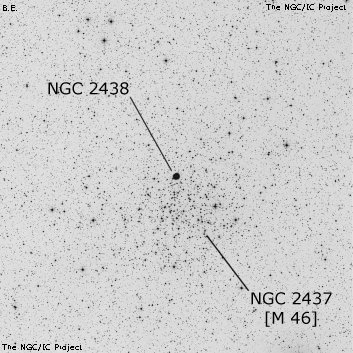NGC/IC Project Restoration Effort
(This is a very very beta version)
NGC2438


Basic Information
Location and Magnitude
Right Ascension: 7:41:50.6
Declination: -14:44:5
Constellation: PUP
Visual Magnitude: 10.8
Historic Information
Discoverer: Herschel W.
Year of discovery: 1786
Discovery aperture: 18.7
Observational
Summary description: planetary, pB, pS, vlE, r, 3s.75 d
Sub-type: PN
Steve's Notes
=====
NGC 2438
48" (2/20/12): at 488x, much of the same detail described in the 4/15/10 observation was seen, though not as much detail in the ring. Besides the slightly off-center bright star (the ionizing star is a mag 17.5-18 companion) and a mag 14.5 star ~15" SW, a 16th mag star is at the edge of the rim on the SW side. A mag 16 star on the SE side appears just inside the bright ring. Finally another 16th mag star is near the north edge of the annulus, but clearly within the planetary, for a total of 5 interior stars. The outer rim brightens at this point in a 90¡ arc to the east and is slightly flattened. The challenging Calabash Nebula (protoplanetary) lies 6.5' ENE.
48" (4/15/10): at 700x, NGC 2438 was a beautiful "cheerio" ring with a sharply defined rim of 1.2' diameter and a fairly large, dark central hole of 25-30". The mag 12.8 star in the center was prominent with a second mag 14.5 star ~15" SW of center. A third mag 16 star was just inside the annulus on the SE side, ~20" from center. The rim had a very uneven surface brightness with an impression of some radial streaks and one or two additional faint, embedded stars. The rim was noticeably brighter along the NE quadrant and to a slightly lesser extent along the opposite SW portion of the rim, creating a bipolar appearance. A bright mag 11 star is just off the SE side and the planetary floats in the beautifully rich star field of M46.
18" (2/24/06): beautiful view of this 70" planetary within M46 at 323x. The annulus is quite prominent and relatively thick with a weakly glowing interior. The rim is irregularly lit and a bit weaker on the NW side and brighter along the eastern edge. A mag 12.8 star is just NW of the center of the annulus (this is not the central star, though) and a fainter interior star (mag 14?) on the SW side (half-way to the rim) was also visible. A mag 11 star is just off the SE edge. At 807x, the rim is noticeably brighter and thicker on the eastern half compared to a weaker section along the NW side and an extremely faint star intermittently pops out on the NNE side on inner edge of the annulus (confirmed on 3/4/08 at Lake Sonoma).
17.5" (3/2/02): at 280x this is a beautiful, 1' diameter PN with a darker central hole at 280x situated on the NE side of the rich oc M46. A mag 13 star (not the central star) is within the central hole slightly offset NW of center. The rim is fairly uniform but slightly brighter along the NE side. The 20" central hole is clearly darker although there is not a dramatic contrast. A brighter mag 11 star is just off the SE edge (about 15"-20" SW of the mag 11 star, a faint mag 14-15 star was also intermittently visible) and a string of faint stars oriented WNW-ESE is just over 1' S. M 1-18 is located 22' NNE of NGC 2438.
13.1" (1/18/85): star near center very easy and second interior star definite.
13.1" (1/28/84): annular planetary on the NE side of M46! Fairly bright, moderately large, round, 1.0' diameter. A mag 11 star is just off the SE edge and a mag 13 star is just NW of the geometric center (this is not the central star). A third extremely faint star lies on the SW side.
13.1" (11/5/83): clearly annular at 166x.
8" (1/1/84): slightly darker center, fairly small, round.
80mm (1/15/07): visible continuously in the finder using an OIII filter and a 13mm Nagler (25x) as a very faint, very small disc on the NE side of M46.



